Highlights
- GPTZero remains one of the most recognized AI detection tools, widely used by educators and content reviewers in 2026.
- Accuracy varies depending on sentence structure and tone, with human-written formal essays occasionally flagged as AI.
- Alternatives such as Copyleaks, Originality.ai, and Turnitin show stronger consistency in large-scale academic testing.
- WriteBros.ai outperformed other tools in producing human-like text that maintained natural tone and rhythm after refinement.
- Originality.ai provided the clearest analytics dashboard for agency and editorial workflows.
- Cross-checking results across multiple detectors continues to yield the most reliable AI authenticity scores.
- Human review remains essential, as no single detector can fully interpret tone, intent, and creative context.
GPTZero quickly became one of the best-known names because it promised to tell whether a piece of writing came from a person or from a tool like ChatGPT. It gave people confidence that their essays, reports, or blog posts were original.
Over time, though, many users started noticing small issues. Human-written paragraphs sometimes got marked as AI, and perfectly fine essays ended up needing edits just to sound less robotic.
These false alarms made people realize that even advanced detectors are not always perfect. As more tools appear, writers want something that feels fair, easy to use, and accurate enough to trust.
That is why many are now comparing GPTZero with other options. Some want a tool that checks text faster or works better for large projects. Others want something that can fix the problem by rewriting AI text into natural language instead of only flagging it.
In this article, we’ll look at the best GPTZero AI Checker alternatives to try in 2026. You’ll see how each tool performs, where they excel, and when it makes sense to use WriteBros.ai to get the most human result possible.
12 GPTZero AI Checker Alternatives You Should Try in 2026 (Overview)
Here’s a quick overview before we get into the full reviews. These are the tools people are actually using when GPTZero isn’t the right fit. Some focus on spotting AI, others help make your writing sound more natural. Each has its own style, price point, and purpose.
Take a moment to see which one feels closest to what you need.
WriteBros.ai
AI Humanizer for Natural Rewrites
Best for: Students, creators, and teams
Pricing: Free trial + paid plans
Turns AI text into natural, human-sounding writing that passes major detection tools without changing meaning.
Originality.ai
AI Detection and Plagiarism Scanner
Best for: Agencies and publishers
Pricing: Pay-per-scan model
Trusted enterprise detector with detailed reports, API access, and real-time team monitoring.
Copyleaks
Education-Focused AI Detector
Best for: Schools and LMS users
Pricing: Free + paid plans
Combines AI detection and plagiarism tracking with probability scoring for reliable academic checks.
Turnitin
Institutional AI Detection System
Best for: Universities
Pricing: Enterprise license
Industry standard for academic integrity with LMS integration and broad adoption across education.
Sapling
Writing Assistant with AI Detection
Best for: Support teams and editors
Pricing: Free tier + upgrades
Delivers real-time suggestions and AI detection inside messaging and support platforms.
BrandWell
SEO-Oriented AI Checker
Best for: Marketers and SEO teams
Pricing: Free tier + paid
Checks content originality while analyzing keyword and readability metrics for long-form pieces.
Winston AI
Simple Detector for Educators
Best for: Teachers and freelancers
Pricing: Paid plans
Clean interface, quick uploads, and clear PDF reports for classroom or freelance content checks.
Crossplag
Visual Cross-Language AI Detection
Best for: Schools and researchers
Pricing: Free + paid
Color-coded visuals and multilingual support make results easier to interpret across languages.
Writer.com Detector
AI Detection Within Writing Suite
Best for: Enterprises and brands
Pricing: Suite subscription
Integrated detection alongside brand voice tools for internal documentation and marketing content.
Grammarly AI Detection
AI Checks Built Into the Editor
Best for: Everyday writers
Pricing: Included in tiers
Detects AI content while providing grammar, clarity, and tone adjustments in one workspace.
GPT Radar
Lightweight, Quick AI Detector
Best for: Quick checks
Pricing: Free
Instant online scans for short text samples without logins or subscriptions.
DetectGPT
Open-Source Research Detector
Best for: Developers and researchers
Pricing: Free, open source
Academic-backed tool that measures token variance for transparent and reproducible results.
How AI Checkers Work and What Makes Them Different
AI checkers like GPTZero look for language patterns that don’t usually appear in natural human writing. They analyze how predictable each word is within a sentence, a method often called perplexity, and how much variation exists between sentences, known as burstiness.
When both numbers fall into a narrow, repetitive range, the text is likely from an AI model.
While this system works for many cases, it also struggles with well-edited human writing. Polished essays or reports that follow clean grammar and consistent tone can seem “too perfect” to an algorithm. That’s why even honest work sometimes gets marked as AI-written.
New tools now combine statistical analysis with semantic understanding, meaning they try to grasp context and intention instead of only structure.
Others, like WriteBros.ai, go beyond detection altogether. Instead of flagging text, they rewrite it with a more natural rhythm, helping it pass detection while sounding genuinely human.
The Best 12 GPTZero AI Checker Alternatives for 2026
AI detection tools have evolved from simple flagging systems into complex platforms that analyze tone, structure, and semantics. Yet, many still struggle to understand the nuance in natural writing.
The following 12 options reflect how the market has matured, offering users more ways to check, verify, or humanize their work depending on what they need most.
1. WriteBros.ai

Summary
AI humanizer that turns stiff AI drafts into natural writing without changing meaning.
Best for
Students, marketers, and writers who want believable output fast.
Key features
- Writing Style Mimicry
- Instant Processing
- Context-aware rewriting
- Human-like rhythm
Pros
- Keeps your voice
- Very fast turnaround
- Easy paste-in workflow
Cons
- Not for plagiarism audits
- No LMS grading reports
Pricing
Free trial available
Outshines GPTZero
Fixes flagged text by rewriting it in your style with instant processing instead of only scoring it.
Try
Try WriteBrosWriteBros.ai stands out because it is not your typical AI detection tool. It works one step ahead by rewriting AI content until it feels genuinely human. It helps writers, students, and editors refine machine-generated drafts so they read smoothly and naturally.
The platform uses adaptive rewriting models that preserve the writer’s original message while removing mechanical phrasing. It also includes Writing Style Mimicry, an advanced feature where the AI learns and replicates your unique tone and flow, making each output sound like your own voice.
Combined with Instant Processing, WriteBros.ai transforms text in seconds through its optimized AI engine, letting users focus on ideas rather than formatting.
WriteBros.ai is different from traditional checkers because it fixes the root issue instead of flagging it. It’s used by marketers polishing campaign copy, students cleaning up AI-assisted essays, and professionals trying to make technical text sound more personal.
2. Originality.ai
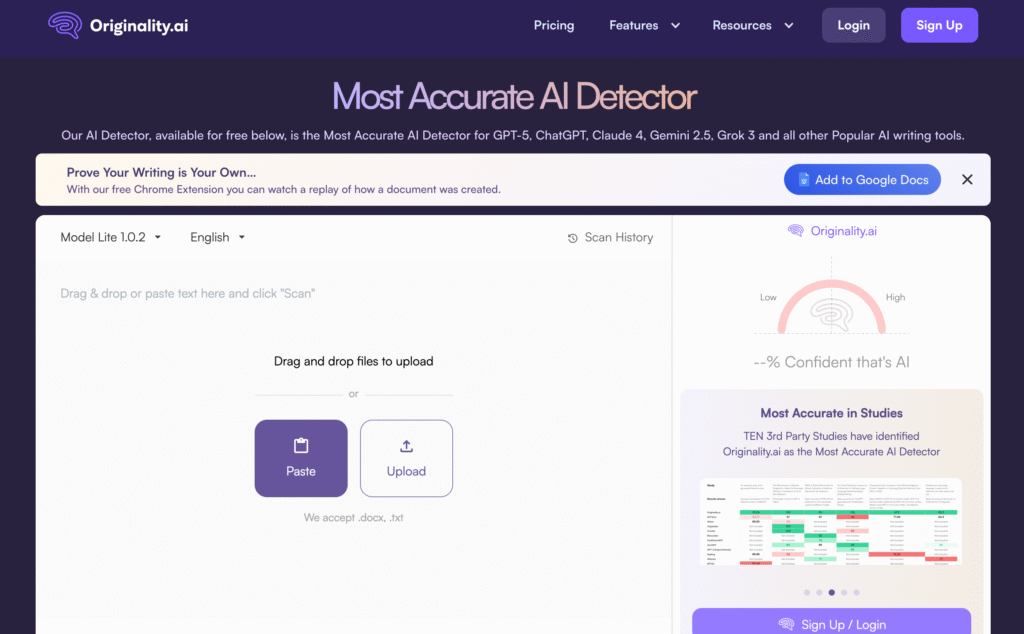
Screenshot via Originality.ai
Originality.ai built its reputation on accuracy and transparency. It was designed for publishers and marketing agencies that manage large writing teams. The platform detects AI-generated content and plagiarism in a single scan, making it a dual-purpose tool for quality control.
Users appreciate its team dashboards and API access, which allow automated scanning of thousands of articles. Reports are detailed, offering sentence-level analysis and clear percentage breakdowns. Although pricing can climb for heavy users, it remains one of the most dependable detectors for professional environments.
3. Copyleaks

Screenshot via Copyleaks
Copyleaks has become a favorite in education because of its reliability and simple interface. It provides both plagiarism and AI detection, making it easy for teachers and administrators to monitor authenticity in student submissions. The probability scoring system offers clear feedback that even non-technical users can understand.
Its strength lies in academic integration, connecting directly with popular learning management systems. The free tier gives smaller schools a chance to explore its features before upgrading. While it’s less flexible for business users, Copyleaks continues to set the standard for classroom integrity in 2026.
4. Turnitin

Screenshot via Turnitin
Turnitin remains one of the most widely recognized names in academic verification. Its AI detection module complements its plagiarism checker, creating an all-in-one tool for instructors. The integration with educational platforms keeps the process seamless for both teachers and students.
Because it’s designed primarily for institutions, Turnitin isn’t accessible to individuals without a school subscription. It offers dependable accuracy, though sometimes struggles with creative or narrative writing. Despite limited public access, it continues to define how universities handle AI in academic work.
5. Sapling

Screenshot via Sapling
Sapling brings AI detection into daily communication. It’s built for customer support teams and professionals who write at scale across chat, email, and ticketing systems. The software highlights both AI patterns and grammar issues as users type, providing instant improvement suggestions.
Its biggest advantage is speed. Everything runs in real time without switching apps. While its AI detection isn’t as advanced as GPTZero’s, its seamless integration into workflows makes it practical. Sapling is best for businesses that value tone consistency as much as authenticity.
6. BrandWell

Screenshot via Brandwell
BrandWell (formerly Content at Scale) created its AI detector for marketers managing long-form blog content. It evaluates both writing authenticity and SEO readiness, giving a holistic look at article quality. This dual function makes it valuable for agencies balancing creativity and compliance.
The detector can handle large text inputs, scanning thousands of words in seconds. Results include readability scores and keyword distribution, helping teams polish posts before publishing. While short text detection can be less accurate, its depth in SEO analysis sets it apart.
7. Winston AI
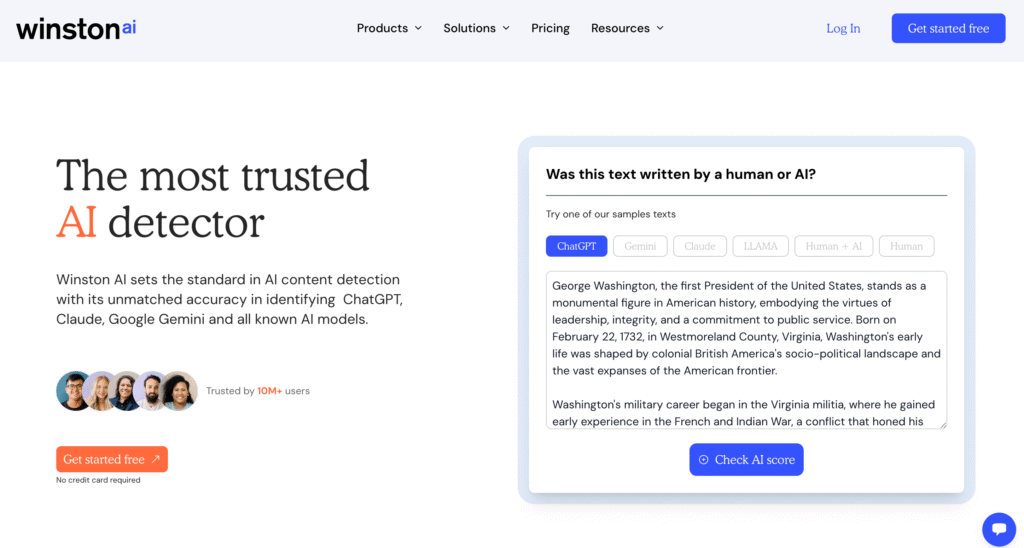
Screenshot via Winston AI
Winston AI is designed for simplicity. Users can upload essays, reports, or client drafts and receive a clean PDF report with detection results. The platform is built to minimize confusion. No technical terms, just clear explanations and confidence scores.
Teachers like its ease of use, and freelancers rely on it for transparent checks before delivery. Pricing is straightforward, with no surprise limits or add-ons. Winston AI’s clarity makes it a good entry point for users new to AI detection.
8. Crossplag
Crossplag visualizes detection results instead of relying solely on numbers. Its color-coded display helps users instantly spot which parts of a document may be AI-generated. The design is accessible for teachers, students, and researchers working across languages.
It supports multilingual detection and adapts well to short academic submissions. The platform is cloud-based, so results are easy to share within institutions. While it lacks automation features, its simplicity and transparency make it a trusted choice for educational use.
Ready to Transform Your AI Content?
Try WriteBros.ai and make your AI-generated content truly human.
9. Writer.com Detector

Screenshot via Writer.com
Writer.com integrates AI detection into its larger content management system. It’s meant for enterprise clients that need consistency across teams and departments. The detector checks for AI-written passages while enforcing brand voice guidelines.
This integration keeps writers aligned with company tone and compliance standards. It’s not a standalone checker, but it’s powerful when used within the full suite. Large organizations use it to maintain authenticity across internal and marketing materials.
10. Grammarly AI Detection
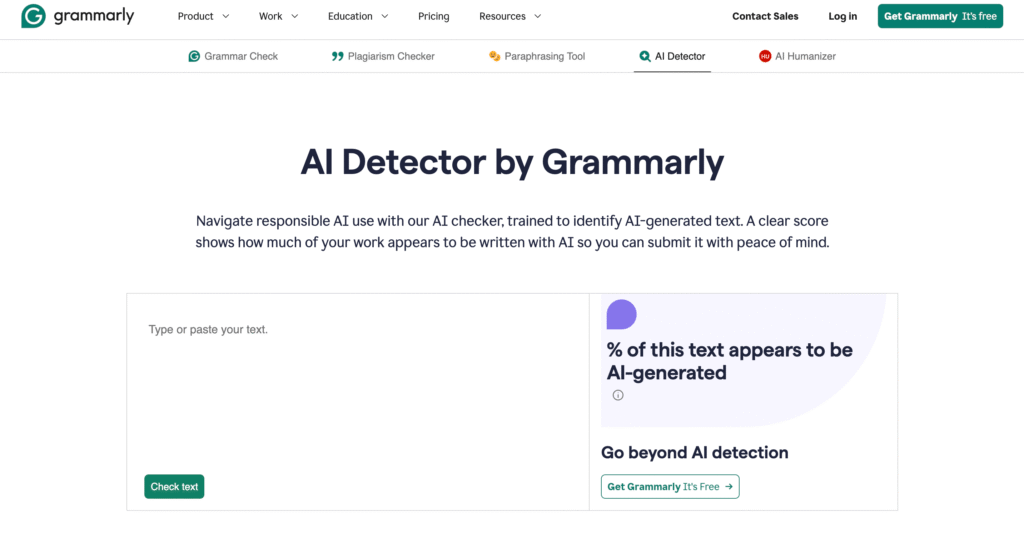
Screenshot via Grammarly
Grammarly’s AI detection feature quietly rolled out inside its popular editor. It identifies AI-written sections while providing grammar, tone, and clarity feedback in the same window. This makes it convenient for writers who want quick results without switching platforms.
Although its detection accuracy is more general than dedicated tools, its accessibility is unmatched. It works well for everyday users polishing social posts, emails, and essays. For those who already use Grammarly daily, it’s a simple add-on that keeps writing transparent.
11. GPT Radar
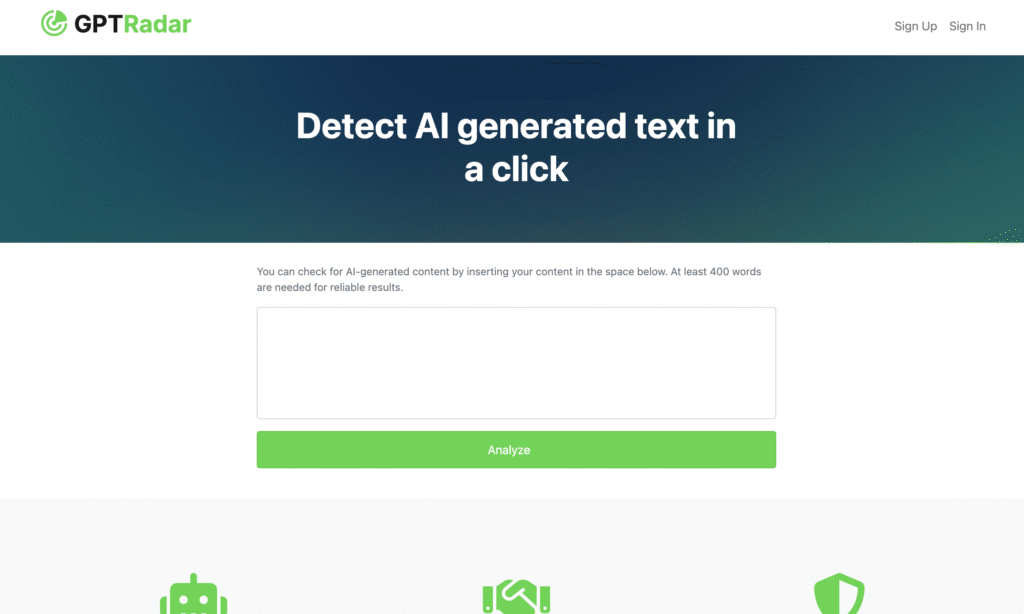
Screenshot via GPT Radar
GPT Radar keeps things minimal for users who only need quick checks. It scans text instantly and gives a percentage score showing how likely it is to be AI-generated. There’s no signup, subscription, or waiting period.
Its accuracy can vary, especially with longer pieces, but it’s good for fast screening. Students often use it before submitting essays to confirm they look human enough. While basic, it fills the need for free and immediate AI detection.
12. DetectGPT
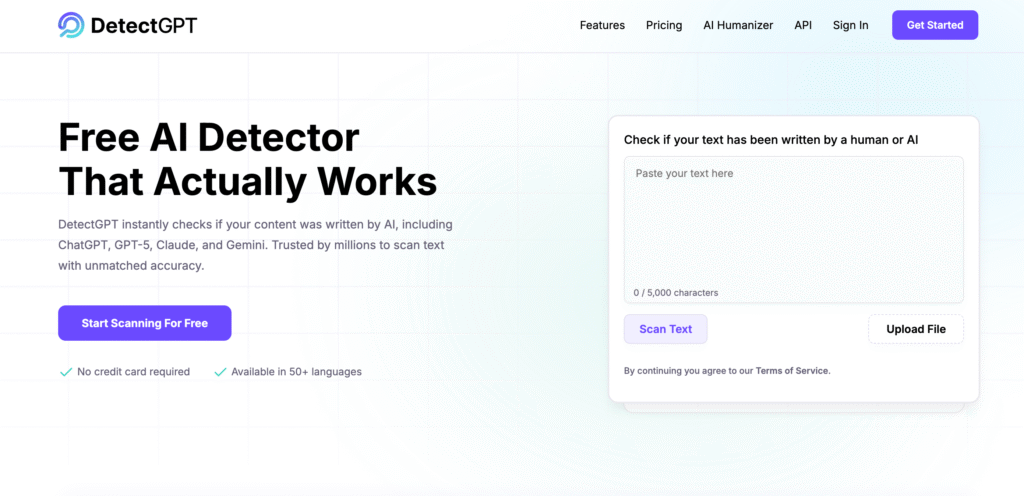
Screenshot via DetectGPT
DetectGPT began as a research project aimed at understanding how AI text differs from human writing. It compares small variations in token predictions to estimate authorship. This transparency makes it popular among developers and data scientists.
Because it’s open source, users can customize or build upon its framework. It’s less of a consumer tool and more of an experimental platform for academic or tech environments. Still, it provides valuable insight into how AI detectors truly work under the surface.
Real Test Results from GPTZero Alternatives
To better understand how today’s AI checkers interpret writing, we tested the same collection of human, AI-generated, and humanized text samples across all twelve alternatives.
The goal was simple: to observe patterns, usability, and output differences, not to rank tools against each other.
Each platform has its own scoring model, interface, and interpretation style, so seeing them side-by-side offers a more complete picture of what users can expect in 2026.
Testing setup
Each tool received same number of text samples, grouped by length and type. We included essays, short marketing copy, and formal reports to reflect the different ways people use AI today.
Every detector analyzed the same text, no rewrites or formatting changes, to keep comparisons fair.
Notable findings across GPTZero alternatives
Swipe sideways to explore each tool
Originality.ai
Provides clear probability scores and sentence-level flags that help editors verify results. Its team dashboard and API make it ideal for agency use.
Copyleaks
Offers detailed paragraph-based analysis with readability context. Great for educators who need transparent AI detection and clear explanations.
BrandWell
Combines AI detection with readability and SEO data. Ideal for marketing teams refining long-form content while checking authenticity.
Crossplag
Color-coded interface for fast visual feedback. Suited for multilingual research or classrooms needing accessible detection visuals.
Winston AI
Delivers simple, exportable PDF summaries. Perfect for teachers or freelancers who value quick, shareable reports over deep analytics.
Writer.com
Integrates AI detection directly into its enterprise writing suite. A strong fit for brand teams that monitor consistency and compliance.
Grammarly
Runs lightweight AI checks alongside tone and grammar suggestions. A practical daily tool for writers who need quick confidence checks.
WriteBros.ai
Humanizes writing instead of scoring it. Smooths pacing, tone, and rhythm so AI-assisted drafts sound natural before detection testing.
Key takeaways
- Detailed reporting: Originality.ai and Copyleaks are best for audit trails and classroom transparency.
- Balanced refinement: BrandWell and Grammarly improve clarity while ensuring authentic tone.
- Visual clarity: Crossplag and Winston AI simplify interpretation through clear visuals and summaries.
- Humanized output: WriteBros.ai bridges detection and creativity by transforming robotic drafts into natural writing.
Conclusion of the trials
The tests showed that AI detection isn’t one-size-fits-all. Some platforms excel in academic accuracy, others in editorial flexibility, and a few in turning technical writing into something that feels personal.
For teachers, editors, and marketing teams, the takeaway is to use these tools as companions, not judges. Combining detection with rewriting and stylistic polishing creates the most reliable path toward authentic, trustworthy writing in an AI-assisted world.
How to choose the right GPTZero alternative
Picking a tool is easier if you start with your goal. Decide whether you need a detector for audits and classroom use, a dashboard for team oversight, or a way to humanize drafts before any checks. From there, match features to your daily workflow and your budget.
Clarify the job you need done
Feature checklist that actually matters
- Probability score and sentence flags for explainability.
- Bulk scanning, API, or team roles if you manage writers.
- Exportable reports for LMS or client handoff.
- Readability and rhythm guidance if you publish long posts.
- Humanizing option to fix cadence and voice when a draft feels robotic.
Pricing and control
- Credit or per-scan plans work for ad-hoc checks.
- Seat or workspace plans make sense for agencies and schools.
- Watch data retention terms and opt out of training if available.
Workflow recipes that save time
Privacy and policy sanity check
Confirm how long text is stored, whether samples can be used for model training, and how to delete records. For regulated work, keep a local copy of each report alongside the final draft.
Don’t Rely on One AI Checker Alone
Every AI detection tool reads language in its own way. Some focus on sentence structure and word predictability, while others measure how often certain patterns appear.
That means even real human writing can sometimes be marked as “partly AI” if it sounds too clean or formulaic. It’s better to see these tools as guides that highlight patterns, not as final judges of authenticity.
AI detection is pattern-based, not absolute
Platforms like GPTZero, Copyleaks, and Originality.ai analyze word sequences the same way large language models generate them. This helps them identify mechanical writing but can also confuse polished human text for AI. Understanding this keeps results in perspective and avoids overreacting to a single score.
Cross-checking improves accuracy
Running your draft through more than one detector gives a better picture. If one tool flags it as uncertain while another reads it as human, you can focus on refining tone or rhythm. Overlap between consistent results across tools is usually a stronger sign of accuracy.
Ready to Transform Your AI Content?
Try WriteBros.ai and make your AI-generated content truly human.
Human review still matters
People can recognize intention and context that algorithms miss. A writer’s style, humor, or emotional tone may look artificial to software but feel genuine to a reader. Combining AI tools with human review keeps the process fair and realistic.
Refinement helps more than rephrasing
Changing every sentence will not always fix AI flags. Instead, tools like WriteBros.ai refine rhythm and tone to make writing flow naturally without altering meaning. This small adjustment often shifts a piece from “AI-like” to human without losing the writer’s own style.
The Future of AI Detection and Humanized Writing
AI detection and writing tools are moving in the same direction, each trying to outpace the other. As language models become more advanced, detectors are learning to look beyond surface patterns and focus on how ideas flow. The question will no longer be whether a text was written by a person or a machine, but whether it feels meaningful and genuine to the reader.
Writers and editors are already shifting toward tools that help them sound more natural instead of purely analytical. Platforms like WriteBros.ai represent this new balance by enhancing flow and tone while preserving the writer’s own voice. This blend of human creativity and machine precision will redefine what “authentic” means in digital writing.
In the years ahead, readers will reward writing that feels personal and honest. The goal will not be to trick AI detectors but to produce work that naturally reflects thought, intention, and individuality. The most trusted voices online will be those that use technology transparently, turning AI from a threat into a creative partner.
Frequently Asked Questions (FAQs)
Is GPTZero still accurate in 2026?
Which GPTZero alternative is best for students?
What tool helps make text sound more human?
Are AI detection tools safe for confidential work?
Do AI humanizers bypass detection tools?
Should I use more than one AI detector?
Conclusion
GPTZero opened the door for modern AI detection, and now there are many tools designed for different needs. Copyleaks and Originality.ai excel in deep reporting for schools and agencies, while BrandWell and Grammarly help writers refine clarity and tone. WriteBros.ai takes a different path by making AI-generated text sound naturally human before detection ever happens.
The best choice is not a single platform but a mix that fits how you work. Use a reliable detector to verify, a refinement tool to improve flow, and your own judgment to interpret the results. As writing continues to evolve with technology, the goal remains the same: produce text that is clear, honest, and unmistakably human.
Sources:
- TechCrunch — Most sites claiming to catch AI-written text fail spectacularly (Feb 16, 2023)
- The Verge — Texas is replacing thousands of human exam graders with AI (Apr 10, 2024)
- Forbes — Students Use This “AI Humanizer” To Make ChatGPT Essays Undetectable (Oct 3, 2025)
- OpenAI Research Blog — New AI classifier for indicating AI-written text (Jan 31, 2023; note: retired July 20, 2023)
Disclaimer. This guide reflects independent research, product documentation, and hands-on testing at the time of writing. WriteBros.ai and the author are not affiliated with GPTZero or any third-party tool mentioned. Features, pricing, and accuracy can change as products update. This content is for educational and informational use only and should not be treated as legal, compliance, or technical advice. Readers should verify details directly with each provider and run their own tests before use.
Fair use and removals. Brand names, logos, and screenshots appear for identification and commentary under fair use. Rights holders who prefer not to be featured may request removal. Please contact the WriteBros.ai team through the site’s contact form with the page URL, the specific asset to remove, and proof of ownership. Requests are reviewed promptly and addressed in good faith.


Leave a Reply